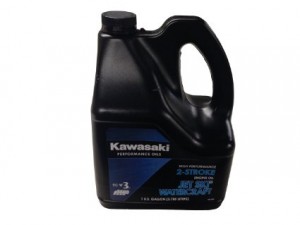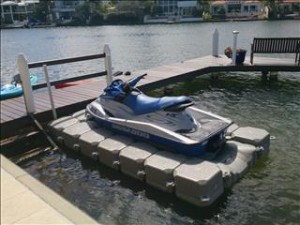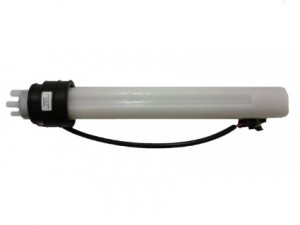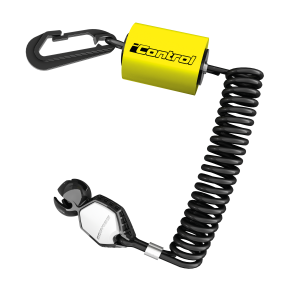In addition to understanding how a Jet Ski propulsion systems works, you need to have a mechanical understanding of other components of your Jet Ski. Repairs and modifications are not incredibly challenging to make, but if you lack the right knowledge, they can seem impossible. You need to be aware of a Jet Ski’s wear ring, its function, and how to tell when yours is getting old. The wear ring, as its name indicates, is a ring that will wear out over time that is fastened around the impeller. Unfortunately, as with all other mechanical parts, the wear ring breaks down over time and you will likely need to replace one if you own a Jet Ski for any substantial amount of time. Every minute of fun spent accelerating your Jet Ski will decrease the useful life of the wear ring. You must understand that the wear ring, combined with the impeller, is crucial to the process of water jet propulsion.
Impellers vs Propellers
Understanding the function of the wear ring is dependent on understanding the impeller. The impeller on a Jet Ski is very similar to the propeller on an airplane, but it creates propulsion using water instead of air. The impeller helps to push water behind the Jet Ski to facilitate motion, but an old wear ring will inhibit the impeller’s ability to do so.
Achieving Propulsion
The wear ring is designed to fit around the impeller with a small gap (approximately .005”) between the edge of the impeller blades and the edge of the pump housing. Over time, each impeller rotation eats away a little bit more of the wear ring due to the abrasive nature of flowing water between the impeller blade tips and the inside diameter of the pump housing. In addition to that, small particles of debris in the water are frequently sucked through the pump. Debris further decreases the useful life of the wear ring by causing ruts and gouges. As the wear ring slowly breaks down, the space between the impeller and the wear ring will grow.
When to Replace a Wear Ring
There are a few common signs that will help you identify an old wear ring. If you notice any of the following common symptoms, it is more than likely time to inspect or replace your wear ring:
- Your Jet Ski won’t accelerate as quickly and tops out at a lower speed than before, even though your engine’s RPM operating range seems fine. This will make your Jet Ski feel as though it is sluggish and has lost some power.
- You need to rev the engine to higher RPMs to get the same amount of acceleration and thrust.
- You notice abrasions, grooves, and excessive wear-and-tear when you visually inspect your wear ring. When the gap between the impeller blades and the wear ring increases (beyond .005”) due to erosion, you will lose a lot of energy because it passes around the impeller.
Conversely, a new wear ring will give you optimal speed and acceleration by efficiently pushing water behind your Jet Ski.
Coast Guard Requirements for Personal Watercrafts
Jet Skis are a blast to ride, but many people don’t understand why newly manufactured Jet Skis have a top speed limited to 65mph. Common rules and regulations have been created to ensure people’s safety, but in particular, the coast guard has come to an agreement with manufacturers that affects the top speed of stock Jet Skis. Personal watercraft and Jet Skis are very safe if you have any amount of common sense, but the top speeds have been limited as an extremely cautious preventative measure to further protect watercraft enthusiasts.
Limiting the Top Speed of Watercraft
Before 1999, there were little to no regulations on Jet Skis and other personal watercraft. Unfortunately, the lack of regulations during this period of time created unnecessary risks for people who just wanted to have fun on the water. Many times an unsuspecting rider would lose control and become seriously injured due to the lack of regulations. Since this time period, Jet Skis and other watercraft have become exponentially safer – even at top speeds. However, the coast guard wanted to impose rules that many felt were unreasonably stringent.
To address this problem and to protect the general boating population, the Coast Guard and personal watercraft manufacturers created a ‘gentlemen’s agreement’ in 1999 to limit the top speeds of Jet Skis to 65 mph. Though the agreement is informal, manufacturers choose to comply to improve the safety of their products.
What’s interesting is that no regulatory agency has stepped in and created legally binding rules to control the manufacturing of Jet Skis. However, when you consider the agreement with the Coast Guard to limit top speeds from a reputational perspective, things make a little more sense. For example, a Jet Ski manufacturer wouldn’t want to be well known for creating Jet Skis that don’t comply with the Coast Guard’s suggestions. In addition, there are ethical considerations as well.
Manufacturer’s Concerns for Safety
However, despite the fact that manufacturers intentionally limit the top speed of Jet Skis, it is still entirely possible – and legal – to modify your Jet Ski. Because the agreement between the Coast Guard and top PWC manufacturers is not a binding agreement, this is not illegal. To do so, you simply need to purchase aftermarket parts and upgrade components on your Jet Ski.
You will want to keep this in mind if you decide to purchase a used Jet Ski, however. Be sure to ask the owner if the watercraft was modified at all to make it faster. If you have already purchased a Jet Ski and discovered that the previous owner made modifications that you don’t like, you can always undo their changes with a few new parts.
In the end, remember to use good judgment when riding your Jet Ski. Though modifications to soup-up the top speed of your Jet Ski are incredibly fun, modifications may not always be appropriate for brand new and inexperienced riders.
Jet Ski Propulsion
How a Jet Ski Works
For those of us that are not experienced with operating and maintaining watercraft, it may feel like a mystery as to how a Jet Ski actually works. If you aren’t mechanically inclined, you will want to have a basic understanding of the inner workings of a Jet Ski before you own one. It is essential that you have a basic understanding of the inner mechanical workings of your watercraft for proper maintenance and safety. Additionally, having a bit of background knowledge can help you make the right decisions should you need to hire someone to repair your Jet Ski. One of the most fundamental and important parts of a Jet Ski is its propulsion system, and you need to know how it works before you own one.
Jet Ski Propulsion Systems
Since a watercraft doesn’t have wheels, many people don’t understand the mechanics of how a Jet Ski is able to move through the water so quickly. Essentially, Jet Skis are powered by an internal combustion
engine that pushes water out of the rear of the watercraft to achieve movement. The following is a simplified explanation of how a Jet Ski propulsion system actually works:
 Water enters a chamber that is located on the bottom of the watercraft through grating.
Water enters a chamber that is located on the bottom of the watercraft through grating.- A gasoline engine provides the power to move the water. Often the engines are as powerful as the engine in a small car, and four-cylinder engines are pretty common.
- The engine’s power is transferred to a water pump.
- The water is pushed through a small hole called a nozzle located on the rear of the Jet Ski.
- The nozzle can be turned to facilitate steering. When you push on the handlebars of your Jet Ski, a cable is pulled that directs the nozzle right or left.
Furthermore, some Jet Skis even have a mechanism called a reversing bucket. The reversing bucket directs the water stream forward, under the Jet Ski. This is helpful because it is the foundation of braking systems that help prevent colliding with other watercraft or stationary objects. These braking systems are extremely advantageous, but older models didn’t always have a braking system in the past. Fortunately, today’s Jet Skis are safer than ever before.
How the Water Jet Moves the Jet Ski
The driving physics principal behind the design of a Jet Ski’s propulsion system is Newton’s laws of motion. Newton’s third law states, “For every action there is an equal and opposite reaction.” This law describes why a rocket has the ability to launch and is fundamental to the engineering of Jet Skis. The jet of water that is being pushed out of the nozzle on your Jet Ski is a force that pushes against the relatively stationary water. In turn, the Jet Ski is propelled forward (the opposite reaction of the water jet). Having this basic understanding of a Jet Ski’s propulsion system is fundamental to operating them.
Using Manufacturer Oil
The Best Way to Protect the Life of Your Jet Ski
It may seem like a simple matter to choose the oil you use for your Jet Ski. After all, all you need to know is the viscosity and whether to use synthetic or conventional oil, right? Actually, that isn’t quite exactly the case. If you want to get the best performance and protect the useful life of your Jet Ski, you are better off using recommended oil. Though Jet Skis are more affordable than other types of watercraft, you would be making a huge mistake to not do everything in your power to protect your Jet Ski’s lifespan and resale value.
Why Your Oil Needs to Match Your Jet Ski’s Brand
Despite the marvels of modern engineering, you need to understand that each manufacturer’s product is in some way different from other brands. Each engine wasn’t created equally, and even though specifications like engine size and cylinder count may be the same, the engines are fundamentally different. There are countless proprietary parts that were engineered for different reasons. S ome were engineered for quality, some were made to be more affordable, and the physics behind engines changes with each different model.
ome were engineered for quality, some were made to be more affordable, and the physics behind engines changes with each different model.
As a company engineers a Jet Ski model, they put their prototypes and models through rigorous testing procedures to optimize its performance. As such, they understand the intricate details of why one type of oil performs better than others, and third party oil venders just haven’t done this level of research with each Jet Ski brand. A manufacturer’s focus is much more narrow and specialized than a third party oil supplier that has many types of engines in mind.
The Need for OEM Lubricants
OEM oils and lubricants have specifically been designed by the manufacturer for one sole purpose: lubricating their proprietary engines. Many people have the misconception that one type of motor oil is the same as another. However, OEM lubricants differ in the fact that they are a proprietary formula that also includes other chemicals designed to prevent wear and tear, corrosion, and mitigate the detrimental effects of the process of combustion. Furthermore, many OEM oils are actually designed to clean themselves as they circulate through an engine. Non-OEM oils typically lack this feature. A well designed OEM oil with make your engine perform better, run cleaner, and last longer than cheap third-party oil products.
The Advancement of Oil Technology and Your Warranty
These days, oil isn’t as simple as it once was. Oil and chemistry advancements have led to some top of line oil products, but some non-OEM oils lack some of the advancements that OEM oil offers. In fact, some warranties are even voided if you fail to use OEM oil. You will want to read the fine print on your warranty to make certain you understand the oil requirements for your Jet Ski, or you might suffer the consequences.
Though OEM oils can cost a little more than cheaper alternatives, they are not unreasonably priced and offer your Jet Ski significantly more protection and improved performance. A voided warranty alone is enough of a reason to use OEM oil, but maintaining your Jet Ski’s resale value and longevity are equally advantageous.
Pre-Launch Operation Checklist for JetSkis
A Minnesota woman had a close call when the Jet Ski she was riding on the St. Croix River exploded, breaking her back. Nicole Montez, 20, said she could see the Jet Ski below her when she was airborne. Her friends were close to shore and helped her. Montez broke two vertebrae and must remain on bed rest for a month. While it’s still not clear why the Jet Ski exploded, Montez believes a leak in the gas line ignited the engine.
Montez’s story is a reminder of the how important it is to do a pre-launch operation checklist before riding your Jet Ski. You wouldn’t want your  airline’s pilot to skip a pre-flight checklist before your next flight so why shouldn’t you go through the pre-launch operation checklist for your Jet Ski before going out? For a detailed pre-launch operations checklist for your Jet Ski, you’ll want to refer to your owner’s manual. Checking every item on a Jet Ski’s pre-launch operation checklist is for your safety and is a Jet Ski owner’s responsibility. There are lots of little things to remember. Here is a general pre-launch operation checklist for those times when you are out and your owner’s manual isn’t handy.
airline’s pilot to skip a pre-flight checklist before your next flight so why shouldn’t you go through the pre-launch operation checklist for your Jet Ski before going out? For a detailed pre-launch operations checklist for your Jet Ski, you’ll want to refer to your owner’s manual. Checking every item on a Jet Ski’s pre-launch operation checklist is for your safety and is a Jet Ski owner’s responsibility. There are lots of little things to remember. Here is a general pre-launch operation checklist for those times when you are out and your owner’s manual isn’t handy.
- Drain Plug (s). You might have seen folks put in without plugs but this is not a good idea.
- Don’t forget to unplug the trailer.
- Lifejackets. Make sure everyone riding your Jet Ski is wearing a lifejacket before they get into the water.
- Registration on board. You never know when the Coast Guard will ask to see your registration. You need proof that the vehicle is legally licensed. It’s no different than driving your car.
- Make sure your gas tank is full. An empty tank of gas is a sure fire way to spoil a day on the water. The last thing you want is a tow back to the dock.
- Check the gas lines for leaks.
- A fully charged battery. Again, the last thing you want is a tow back to the dock.
- Don’t forget your safety lanyard. Who’s up for towing their boat for an hour, putting it on the launch and realizing that they left their safety lanyard at home? Nobody.
- Take the tow straps off.
- Secure your Jet Ski’s safety strap around your wrist or secure it to your life vest.
- Safety kit. Be sure to equip yours with the required safety equipment to meet your local codes and laws. A whistle and fire extinguisher are the bare minimums and a 20’ length of rope for emergency tie up or towing is always a good idea.
Be safe and have fun!
Four Steps for Testing Your SeaDoo’s Fuel Sending Unit
Paul Martin of Arnold, Missouri got a wicked deal when he bought his used SeaDoo. But when he took it out for the first time on the lake, the fuel sensor didn’t appear to be working. The previous owner claimed the fuel sensor worked when he had it and so Paul was faced with getting the fuel sensor replaced, repaired or fixing it himself. Fortunately, Paul likes to take things apart but before he did he came to Jet Ski Plus for some advice. Here’s what we shared with Paul about testing his SeaDoo’s fuel sending unit.
Inside your SeaDoo’s fuel tank is a plastic tube known as the fuel pickup, and within this tube is an integrated fuel sending unit. The sending unit is made up of a long narrow circuit board with 9-12 Reed switches and several resistors. These Reed switches and resistors are wired so that the total r esistance across the circuit board increases as each Reed switch closes from the bottom of the tank to the top. Regardless of the model and year of your SeaDoo, the resistance ranges from 90 to 0 Ohms, with 90 Ohms representing an empty tank and 0 Ohms representing a full tank. These Reed switches are activated by a magnet attached to a float that rides up and down internal rails with the fuel level.
esistance across the circuit board increases as each Reed switch closes from the bottom of the tank to the top. Regardless of the model and year of your SeaDoo, the resistance ranges from 90 to 0 Ohms, with 90 Ohms representing an empty tank and 0 Ohms representing a full tank. These Reed switches are activated by a magnet attached to a float that rides up and down internal rails with the fuel level.
While the design is simple, the weak link in the system is a one-time fuse on the fuel sending unit’s circuit board. Once the fuse blows, the sending unit is rendered non-functional since the fuse can’t be replaced. Here are the steps we recommend for testing the fuel sending unit for 2-stroke carbureted SeaDoos. Unfortunately, these steps won’t work on fuel injected or 4-TEC SeaDoos.
This quick and easy test will help you diagnose most common problems with the fuel sending unit and doesn’t require you to remove the fuel baffle from the tank. All you need is an Ohmmeter and some time.
- First, you’ll want to locate the fuel sending unit and sending wires. Potted into the side of the fuel sending unit, the wires are pink and pink/black. Follow these wires until you come to the inline 2-wire connector and then disconnect the connector.
- With the connector disconnected, you’re ready to perform a resistance test on the fuel sending unit. This is accomplished by connecting the Ohmmeter to the pink and pink/black wire terminals running to the fuel sending unit.
- With the Ohmmeter connected, you’ll want to record the resistance and approximate level of the fuel in the tank.
- Next, compare your readings with the following that are typical on a good sending unit:
- 0-5 Ohms (Full Tank)
- 45+/- Ohms (Half Full Tank)
- 85-95 Ohms (Empty Tank)
If your Ohmmeter shows an open circuit or infinite resistance, the internal fuse is blown and the sending unit will need to be replaced.
If your ohmmeter reads 85-95 Ohms and the tank obviously has gas, either the float has lost its buoyancy or the magnet has come loose from the float. If either is the case, your fuel gauge would always show an empty tank of gas. In this case, you’ll need to install a new float into the sending unit.
If your fuel gauge seems to be stuck or show the same reading, the float could be wedged inside the plastic tube. Though rare, we have encountered instances where the upper metal hose clamp is so tight that it pinches the fuel sending unit and wedges the float in place.
Certainly there are other potential failures but overall, these scenarios account for close to 90% of the reasons why fuel sending units fail.
Anchoring Your Jet Ski
Spending as much time on the water as possible is the goal of nearly every Jet Ski owner but eventually, even the most passionate enthusiasts have to stop. The problem is there’s a big difference between where you want to stop and where you have to stop. And the reality is where you have to stop isn’t always equipped with convenient docks or launch ramps. In some cases, you may want to stop and hang out for a while at a scenic beach or have lunch on a riverbank.
 The solution of course is an anchor but due to the size of Jet Skis and their storage compartments, anything with real holding power has to be left behind. If only anchoring were as easy as tossing out a weight and your Jet Ski would stay put. To anchor effectively, you need to use the right tools the right way to ensure your Jet Ski won’t float away.
The solution of course is an anchor but due to the size of Jet Skis and their storage compartments, anything with real holding power has to be left behind. If only anchoring were as easy as tossing out a weight and your Jet Ski would stay put. To anchor effectively, you need to use the right tools the right way to ensure your Jet Ski won’t float away.
Anchoring a Jet Ski is a challenge since bottom conditions vary so widely. While a Danforth-style anchor, also known as a fluke, is ideal for biting into a mud or sand bottom, a Danforth-style anchor won’t grip in rocky conditions. If you own a lightweight Jet Ski and you’re out in flat conditions, a mushroom-style anchor will suffice. But if conditions turn windy or rough, a mushroom anchor is easily dragged across the bottom. So before you hit the water, consider the riding environment, where you plan to explore and bottom conditions when choosing the anchor to bring.
While the choices in anchors for mainstream boats seem to be endless, Jet Ski anchors come in only a few varieties. As long as you’re riding above mud or sand, fluke anchors aren’t your only option. Another effective anchor in these conditions is a Grapnel-style anchor. But unlike most flukes, Grapnel-style anchors bite well in mud, sand and gravel or rock. Have you ever been out on the water and realized you left your anchor back at the dock? This is why it’s always good to have a Plan B. Another Jet Ski friendly anchor option is anchor “bags.” These are simply bags with drawstrings or screw-in posts that you fill with sand or rocks from the surrounding riding environment and then drive in the ground for a secure anchoring point. Jet Ski anchor bags are small and most come with a padded storage bag to protect your PWC’s storage compartment.
When it comes to anchoring your Jet Ski, having enough weight or getting enough “bite” on the bottom is essential and so is the anchor’s length of rope (the anchor’s “rode”) secured to your PWC. If you anchor your Jet Ski directly above your anchor on a taut line, even in the most serene conditions, your anchor is certain to fail. Your best bet is to secure your anchor and then play out the correct length of anchor rode. You should plan to have a five-to-one ratio between the depth of the water and the amount of anchor rode you play out. So if you’re anchoring in four feet of water, you’ll need twenty feet of “rode” for the best results.
That said, no matter what anchor you choose and how carefully you employ the five-to-one ratio, you’ll still want to keep an eye on your Jet Ski. Anchors are big enough and Jet Skis don’t weigh enough to trust for very long. But the good news is, Jet Skiers would rather be out riding out on the water anyway.
What You Need to Know About the SeaDoo DESS Key Security System
We get a lot of questions here at Jet Ski Plus about SeaDoo’s DESS Key Security System. Many of our customers want to know what DESS stands for, while others want to know how they can get a new DESS key programmed or why SeaDoo even made DESS keys at all. Here’s what SeaDoo jet ski owners ought to know about its DESS Key Security System.
 In the mid-1990s, SeaDoo began to manufacture jet skis with the DESS Key Security System. The DESS Key Security system, or Digitally Encoded Security System, is a lanyard containing a computer chip with a unique numeric code that the owner connects to the dess post on their jet ski in order to be granted access to start and operate it. In other words, it works just like your car’s key fob, allowing you to enter your car, or jet ski in this case, so you can start the engine and drive it. Like your car’s key fob, the DESS key (lanyard) will only work on your jet ski and no one else’s.
In the mid-1990s, SeaDoo began to manufacture jet skis with the DESS Key Security System. The DESS Key Security system, or Digitally Encoded Security System, is a lanyard containing a computer chip with a unique numeric code that the owner connects to the dess post on their jet ski in order to be granted access to start and operate it. In other words, it works just like your car’s key fob, allowing you to enter your car, or jet ski in this case, so you can start the engine and drive it. Like your car’s key fob, the DESS key (lanyard) will only work on your jet ski and no one else’s.
Why did SeaDoo decide to manufacture jet skis with the DESS Key Security System? Because before the mid-1990s, anybody could hop on any jet ski and take it, no DESS key required. So, SeaDoo decided to distinguish themselves in the marketplace with this added security feature.
The Do’s and Don’ts of Buying a Used Jet Ski
Times are tough. Whether it’s the 10% spike in your home’s electric costs, higher prices at the gas pump or an increasing grocery bill, stretching a dollar these days is even more difficult than it was a year ago. Which is why buying a used jet ski could be an ideal solution for water sports enthusiasts who aren’t able to afford to buy a new one. But as the old adage goes, “let the buyer beware.” Getting a quality used Jet Ski at a fair price means doing your homework. Here are some Do’s and Don’ts to keep in mind if you’re considering buying a used Jet Ski.
 Do ask for at the number of hours a used Jet Ski has been operated. A good indicator of how old the Jet Ski is or how much wear and tear you should expect is the number of hours a Jet Ski has been operated. Jet Skis operated for less than 50 hours tend to be in better shape than Jet Skis operated for 150 hours or more. The average lifespan of a Jet Ski is 300 hours. But usage alone isn’t the only factor you should consider when buying a used Jet Ski. A well-maintained Jet Ski that’s seen 200 hours on the water could be in better shape than a poorly maintained Jet Ski used for 30 hours. If you come across a Jet Ski with a low number of usage hours that looks pretty beaten up, this could be a red flag that the owner didn’t perform the necessary maintenance to keep his or her Jet Ski in peak performance condition.
Do ask for at the number of hours a used Jet Ski has been operated. A good indicator of how old the Jet Ski is or how much wear and tear you should expect is the number of hours a Jet Ski has been operated. Jet Skis operated for less than 50 hours tend to be in better shape than Jet Skis operated for 150 hours or more. The average lifespan of a Jet Ski is 300 hours. But usage alone isn’t the only factor you should consider when buying a used Jet Ski. A well-maintained Jet Ski that’s seen 200 hours on the water could be in better shape than a poorly maintained Jet Ski used for 30 hours. If you come across a Jet Ski with a low number of usage hours that looks pretty beaten up, this could be a red flag that the owner didn’t perform the necessary maintenance to keep his or her Jet Ski in peak performance condition.
And speaking of maintenance, Don’t buy a used Jet Ski without asking to see its maintenance records. This is the best way to see a Jet Ski’s history and whether or not it’s received the proper upkeep, required a rebuild, any other major repairs or been in any accidents. As the current owner if he or she is the only owner. If the Jet Ski had more than one owner, make sure the current owner has the records that show the Jet Ski’s entire lifespan. Conscientious Jet Ski owners will have this information and it shouldn’t be a problem. If it is a problem and they don’t have all the records, keep shopping.
They say you can tell a lot about a person by how well they take care of their things. Do keep this in mind when examining a used Jet Ski for wear and tear. Used Jet Skis are bound to have a few scratches here and there, but while you’re inspecting a Jet Ski’s wear and tear be sure to check out how the seller was storing it. Was the Jet Ski sitting out in the sun? Or was it setting out in the shade? Did the seller have a cover on it? Over the long term, the elements can be damaging to a Jet Ski and the ones that are stored in a garage or shed away from direct sunlight are the ones that will be in the best shape.
Finally, Don’t buy a used Jet Ski without having a mechanic check out the engine. A trusted mechanic will see things you may not see by simply inspecting the exterior of a Jet Ski. Mechanics will be able to tell you if there is a leak or any other problems. If a seller won’t let you have the Jet Ski checked out by a mechanic before you buy it, then that Jet Ski is the one for you.
Jet Skis and Endangered Species
Riding your jetski at high speeds on the water is exciting. But imagine the excitement experienced by Brynjar Thor Gunnarsson of Iceland and his friend when they spotted several humpback whales on their way back home. Naturally, they decided to go and take a closer look and Gunarsson captured the event with a camera on the helmet he was wearing. Problem is, he seriously injured an endangered species.
 Gunnarsson’s video shows him travelling along the water at a fast speed, constantly panning the camera to the right while he attempts to spot the whales’ exact location in the water. But when he turned to look ahead of the vehicle, a humpback whale’s large arced back emerges from the water’s depths and Gunnarsson doesn’t have enough time to get out of the way.
Gunnarsson’s video shows him travelling along the water at a fast speed, constantly panning the camera to the right while he attempts to spot the whales’ exact location in the water. But when he turned to look ahead of the vehicle, a humpback whale’s large arced back emerges from the water’s depths and Gunnarsson doesn’t have enough time to get out of the way.
Despite a small attempt to swerve out of the way, Gunnarsson collides with the humpback whale and continues driving.
How does this become international news? Like millions of us in this information age, Gunnarsson posts his video footage online. He commented that he and his friend came across a group of humpback whales on their way home and that “one came up right in front of my jet ski and I hit it. No harm done though!”
No harm done? Yikes! If he’d run over a human, the person could have been seriously injured or killed. Dr. Conor Ryan, a sightings and strandings officer with the Herbridean Whale and Dolphin Trust called the video “disturbing.” Ryan believes irresponsible driving led to the collision and that the humpback whale more than likely sustained serious injuries given the speed of the collision. Standard practice and the law in most countries is to slow down and steer clear when in the vicinity of endangered or protected species like humpback whales.
While humpback whale sightings on a jet ski outing isn’t the norm, consider the other protected species you might encounter on your next outing. In Florida, certain waters may be home to manatees and hitting one with a jet ski could cost you thousands in fines and even jail time. Riding your jet ski in shallow water, whether along the coast of Florida or in the Midwest, stirs up the bottom and suspends sediments which limit light penetration and deplete oxygen. This in turn affects fish and bird feeding. This is why it’s best to limit riding your jet ski in shallow water, opting to ride instead in main channels. Keeping your jet ski at idle speed will help.
If you plan to ride your jet ski in coastal areas, you should also be aware of low tide. When the tide goes out valuable fish nurseries in sea grass beds and other delicate vegetation are exposed. You should also avoid coming into contact with kelp forests found close to shore which support fish, invertebrates, sea urchins and sea otters. If you have to ride near coral, don’t use an anchor and take caution when diving to avoid coming in contact. Grass marshes, whether in fresh or salt water coastal areas or rivers, should be avoided since nesting birds, frogs, turtles, snakes and alligators could be hidden in the thickets.
Let’s use Gunnarsson as an example of what not to do on your next jet ski outing. A responsible Jet Ski driver rides at controlled speeds so he or she can see any animals ahead, abides by no-wake zones to prevent shoreline erosion and makes him or herself aware of any endangered species possibly found in their riding area. Man and beasts can share the water as long as we respect one another.
